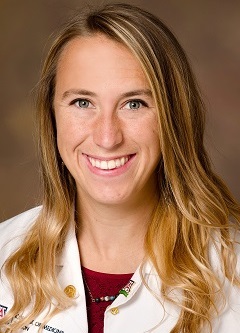For medical students with the University of Arizona College of Medicine – Tucson, weeks of suspense will end on March 15. Otherwise known as Match Day, it’s the day the students will learn where they will go for their residency training, in their chosen medical field, after they graduate from medical school in May.
Sarah Joy Ring, who has completed the College of Medicine – Tucson’s Rural Health Professions Program and a 16-week Rural Health Distinction Track, is hoping for a residency focused on both pediatrics and emergency medicine, potentially in a rural location. Her “capstone” paper, an in-depth research project that all Distinction Track students are expected to complete, carries the impressive title of “A Survey of Rural Emergency Medicine and the Discrepancy of Care for Pediatric Patients that Present to Rural Emergency Departments.”
During her training, she had opportunities to see how important telemedicine can be in rural communities. “I was at sites that had telemedicine capabilities and spent some time chatting with the physicians about them. "I can specifically remember two experiences, one while on my family medicine rotation in Tuba City (in northern Arizona, where students learn about American Indian healthcare) and one during my RHPP summer in Flagstaff” (also in northern Arizona).
“I was at sites that had telemedicine capabilities and spent some time chatting with the physicians about them. "I can specifically remember two experiences, one while on my family medicine rotation in Tuba City (in northern Arizona, where students learn about American Indian healthcare) and one during my RHPP summer in Flagstaff” (also in northern Arizona).
“Tuba City experiences a significant shortage of mental health providers in general, and specifically for children and adolescents," Sarah says.
“As such, they found using telemedicine helpful to connect the children of that region with services that they would otherwise struggle to receive, due to having to travel large distances to receive help, which incurs financial and time burdens for families.
“Moreover, a point that I found particularly enlightening when learning about this service, was with regard to what it means to live in a small population where it is quite likely you know most people living in the region," Sarah says.
“The physicians found that because of this, many adolescents experiencing difficulties often felt uncomfortable sharing with people who lived in the region, out of fear that they may tell someone, or that they were themselves a relative or family friend, which can be a common experience. Having someone to share with who lived out of the region and was not specifically invested in the region and an integral member of the community made many of these adolescents more comfortable with disclosing their experiences.
“I also worked on writing about how telemedicine can be used to augment pediatric services in rural emergency departments for part of my "capstone" project, and found some very positive results from multiple studies. For critically ill patients, one study found that in particular, telemedicine consults improved the access to critical care specialists, resulting in a reduced frequency of physician related medication errors. Moreover, another study found that parent satisfaction was higher with telemedicine consults than with phone consults, which is a particularly important outcome when caring for pediatric patients and their family. Many of these same findings also translated to the pre-hospital environment, where ambulances that utilized telemedicine resulted in better assessments, more interventions in the pre-hospital environment, and improved outcomes for pediatric patients in pre-hospital care.
“Overall," Sarah says, I think that we will continue to find that telemedicine is an excellent resource for rural providers that allows patients to have clinically significant access to additional resources and care that would otherwise be difficult or unavailable to the region."

